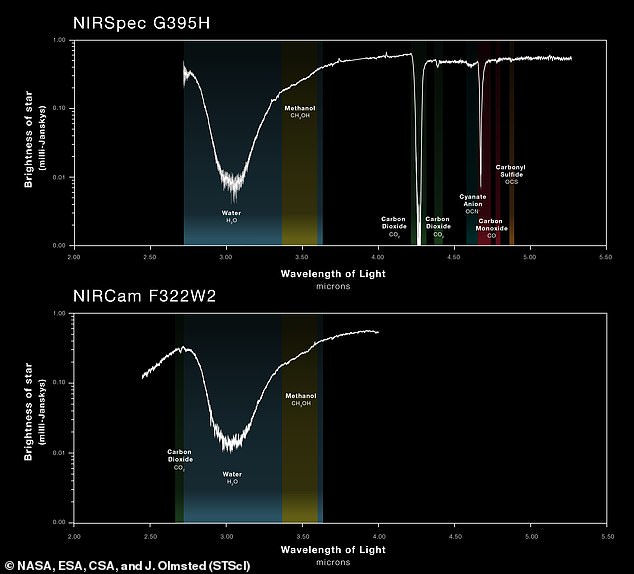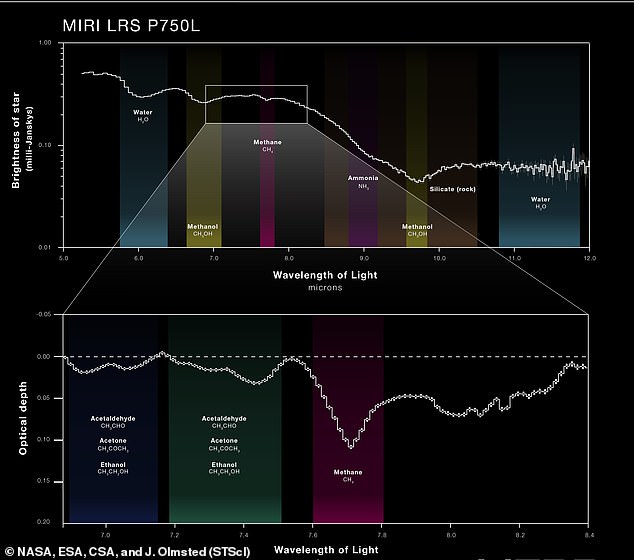NASA’s James Webb sees “building blocks of life” frozen in a molecular cloud
>
NASA’s James Webb Space Telescope (JWST) has found the “building blocks of life” frozen within the deepest, coldest ice ever measured in a molecular cloud.
Methane, sulfur, nitrogen and ethanol were identified in the Chameleon 1 cloud, 500 light-years from Earth, suggesting that these molecules are a typical result of star formation rather than a unique feature of our Solar System.
JWST sent back a never-before-seen image of the icy cloud, which turned out to be the coldest ice ever measured, with a temperature of about -505 degrees Fahrenheit.
Because these elements are necessary for life, the latest data will allow scientists to see how much of each is used to form new planets and allow them to see how habitable the world will be.
Methane, sulfur, nitrogen, and ethanol were identified in the Chameleon 1 cloud (pictured), which is 500 light-years from Earth.
This molecular cloud is so cold and dark that several molecules have frozen into dust grains within it. The Webb data prove for the first time that molecules more complex than methanol can form in the icy depths of such clouds before stars are born,” said NASA’s official Webb Telescope. Twitter account shared.
Using Webb’s infrared abilities, the researchers studied how the icy molecules within absorbed starlight beyond the molecular cloud.
This process left the team with “chemical fingerprints,” or absorption lines, which could be compared to laboratory data to identify the molecules.
In this study, the team targeted buried ice in a particularly cold, dense, and difficult-to-investigate region of the Chamaeleon I molecular cloud, which is currently forming dozens of young stars.
Klaus Pontoppidan, Webb project scientist at the Space Telescope Science Institute in Baltimore, Maryland, said in a statement: “We simply could not have observed these ices without Webb.”
‘The ices appear as dips against a continuum of background starlight. In regions that are this cold and dense, much of the background starlight is blocked, and Webb’s exquisite sensitivity was needed to detect the starlight and thus identify the ices in the cloud. molecular.
On Earth, methane includes emissions from wetlands and oceans and from the digestive processes of termites.
And ethanol comes from the fermentation of starches and sugars.
NASA and the European Space Agency said these elements are essential ingredients in the atmospheres of habitable planets and are the basis for sugars, alcohols and simple amino acids.
Will Rocha, an astronomer at the Leiden Observatory, said: “Our identification of complex organic molecules, such as methanol and potentially ethanol, also suggests that the many star and planetary systems that develop in this particular cloud will inherit molecules in a chemical state pretty advanced.”
“This could mean that the presence of prebiotic molecule precursors in planetary systems is a common result of star formation rather than a unique feature of our own solar system.”
This research is part of the Ice Age project, one of Webb’s 13 early launch science programs. These observations showcase Webb’s observing capabilities and allow the astronomical community to learn how to get the best out of their instruments.

Astronomers have inventoried the most deeply embedded ice in a cold molecular cloud to date.

These lines indicate which substances are present within the molecular cloud. These plots show spectral data from three of the James Webb Space Telescope instruments.
The Ice Age team has already planned more observations and hopes to trace the journey of ice sheets from their formation to the assembly of icy comets.
Melissa McClure, an astronomer at the Leiden Observatory in the Netherlands, concluded: “This is just the first in a series of spectral snapshots that we will take to see how ices evolve from their initial synthesis to the comet-forming regions of protoplanetary disks. “. .
“This will tell us what mix of ices, and therefore what elements, may eventually be delivered to the surfaces of terrestrial exoplanets or incorporated into the atmospheres of gas or ice giant planets.”

